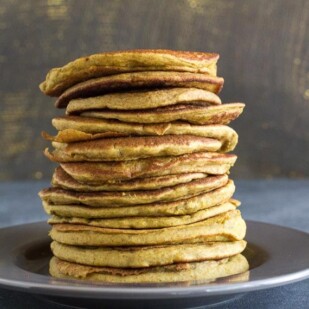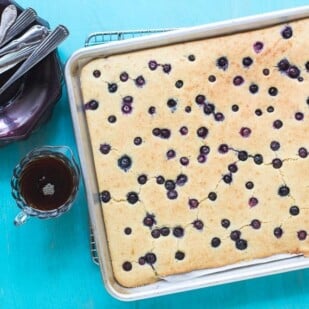3-Ingredient Low FODMAP High Protein Pancakes: rolled oats, lactose-free cottage cheese and eggs. That’s all it takes. If you have some salt and vanilla extract around, you can add them, but you really can make these pancakes with just the three main ingredients. (See Tips for add-ins). They are also gluten-free, if you use gluten-free oats.
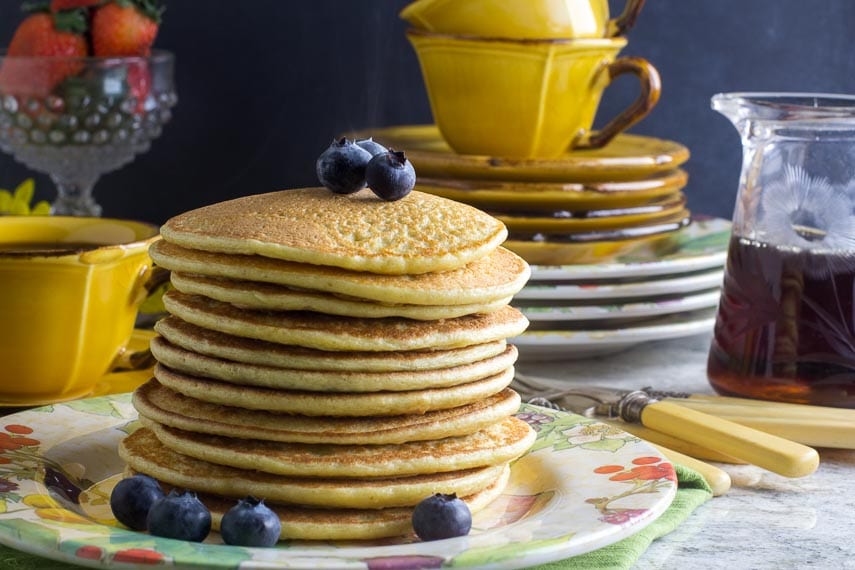
These are not the fluffiest pancakes around – for that we have our Low FODMAP Fluffy Pancakes recipe – but when you have a hankering for pancakes, but also want some nutrition, these low FODMAP high protein pancakes are perfect!
What Makes These Pancakes High Protein?
Each of the main ingredients is a good source of protein:
- Oats contain more protein than many grains, 11 to 17% by dry weight.
- Lactose-free cottage cheese contains 12 g of protein per ½ cup (113 g) portion as is a source of calcium, too. We love Green Valley Creamery Brand, but Lactaid might be easier to find.
- Eggs! We love eggs. They have been called the perfect protein and we love them hardboiled as a low FODMAP snack, in baking, custards and cooking (as in Pad Thai and quiches). Every large egg contains 6 g or protein.
I was first introduced to a version of these high protein pancakes by my former cross-training coach Holly Leonard. If you are anywhere near the north shore of Boston and want to get into the most kick-ass shape of your life, then you have to look her up.
Get Out The Blender
You do need a blender to make these high protein pancakes. I like to place the eggs and cottage cheese in the carafe first for better blending. You might still have to scrape the carafe down once or twice.
Maple Syrup Is Low FODMAP
There are many sweeteners that are low FODMAP sugar, brown sugar and maple syrup being a few. If you are a maple syrup lover be sure to read our article on Maple Syrup for a deep dive into choosing and using this delicious natural sweetener, which we love using in sweet as well as savory cooking.
And we would never use anything else on our pancakes! Leave products on the shelf called “pancake syrup”. Not only are they typically mostly made from high-fructose corn syrup, which is high FODMAP, but they do not contain any real maple syrup and instead rely on maple flavoring, which pales in comparison to the real deal.
Real maple syrup is expensive, but we think it can make or break a pancake or waffle breakfast.
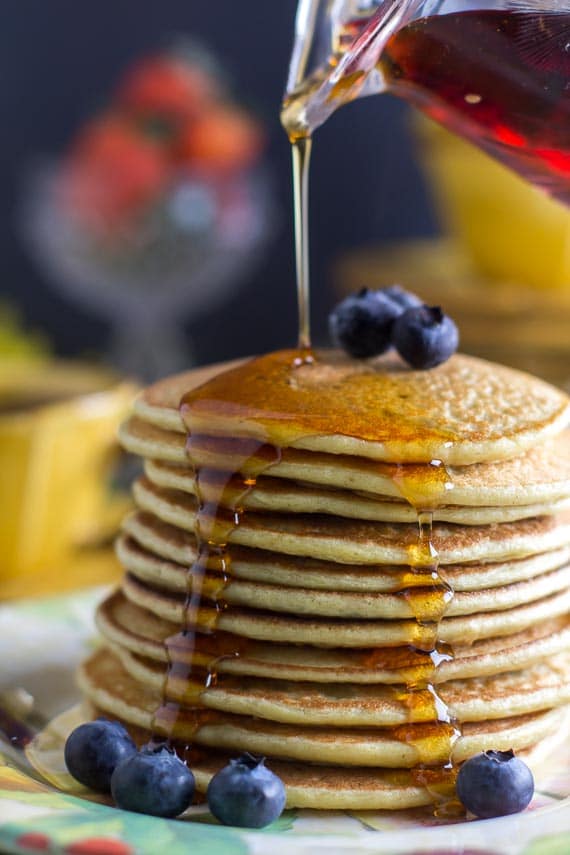
Choosing Low FODMAP Fruit
We love having a side of low FODMAP fruit along with our pancakes and waffles and these high protein pancakes are no exception.
- Strawberries are a fantastic choice as they contain no FODMAPs according to early lab tests by Monash University. More recent tests do show FODMAPs, but there are low FODMAP serving sizes. Differences in lab testing results are actually expected to occur. You can read our article, When Monash University and FODMAP Friendly Low FODMAP Lab Test Results Differ.
- Blueberries were recently re-tested by Monash and their low FODMAP serving size increased from ¼ cup to 1 cup (40 g to 125 g). As this picture demonstrates below, not all blueberries are created equal, when it comes to size. A volume serving of the larger size will mean less berries; conversely more smaller berries will pack into the measuring cup. I am showing you this to encourage you to use a scale and go by weights when using the Monash app. Monash themselves have said repeatedly that this is the most accurate way to use their app.
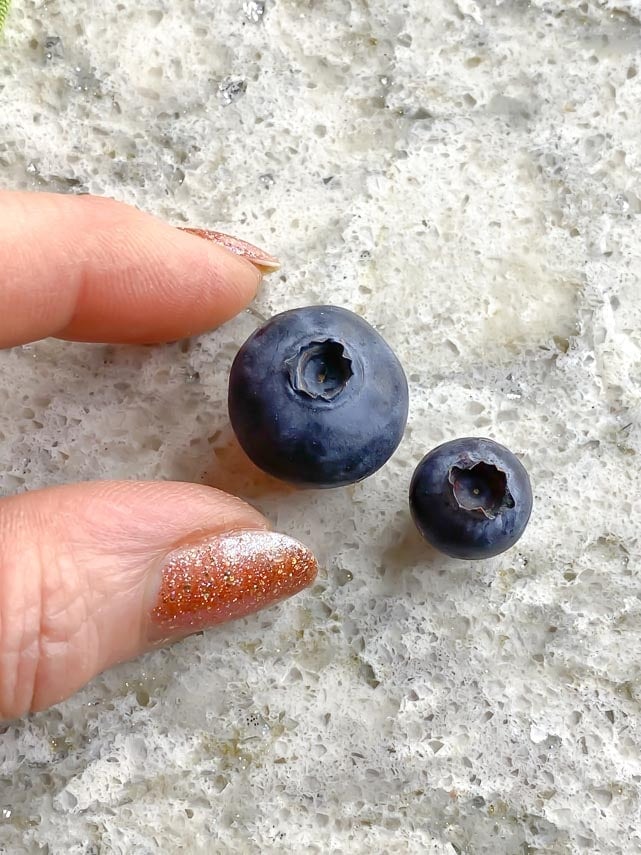
- Bananas get a bad rap, from a low FODMAP perspective, and I think it is because they have been placed on so many “high FODMAP foods” lists. Here are the details.
Bananas According to Monash University:
- 1 medium (100 g) unripe common banana is Green light Low FODMAP
- ⅓ of a medium RIPE banana (35 g) is Green light Low FODMAP.
So, you CAN have a generous portion of ripe bananas. 35 g is plenty to slice up for a bowl of cereal, yogurt or on top of your pancakes.
- Raspberries are another berry that we like along with our breakfast. About ⅓ cup or 58 g of berries is a low FODMAP serving. Again, weight is more accurate.
- Blackberries are a bit more confusing. Blackberries have been lab tested by both Monash University and FODMAP Friendly. The Monash lab results state that 1 small berry at 4g is Green Light low FODMAP. FODMAP Friendly has lab tested blackberries and gives them a “Pass” at 1 cup (150 g), with a Max Serve of 375 g. You can try these berries and assess your own tolerance, which is what is important.
- Yellow Peaches are low FODMAP in 30 g portions according to Monash. Each wedge below is a 30 g amount, which is plenty to slice up on your pancakes.
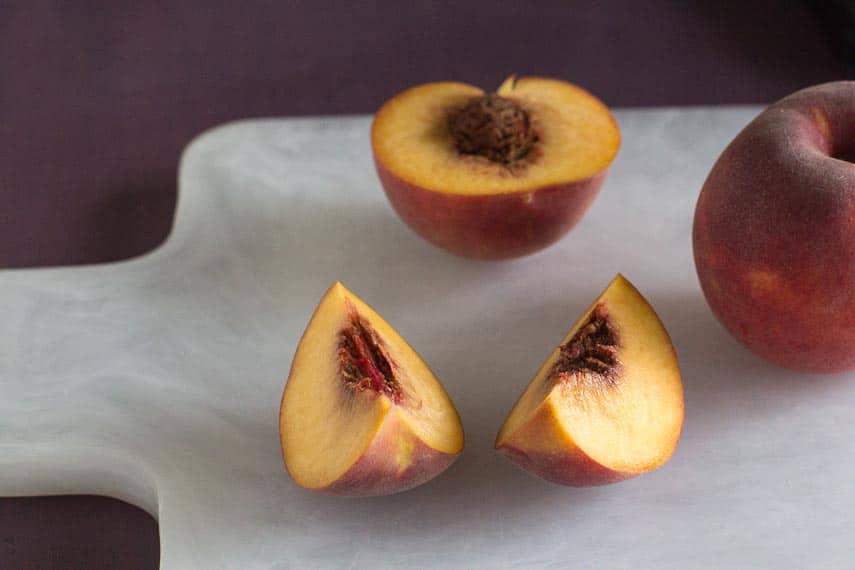
The THREE Ingredients
If you follow a gluten-free diet, make sure your oats are gluten-free, otherwise any whole rolled oats work just fine. The lactose-free cottage cheese will be found with other cottage cheese at the supermarket, or might be in a special section; ask! Look for Green Valley Creamery or Lactaid brands.
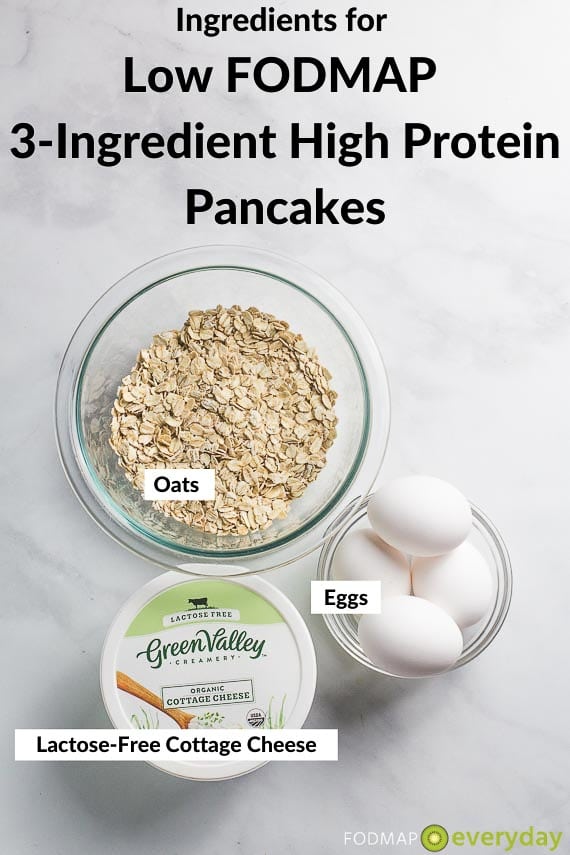
How To Make
Get out the blender (I’m a huge fan of my VitaMix). Throw everything in there – wet stuff first.
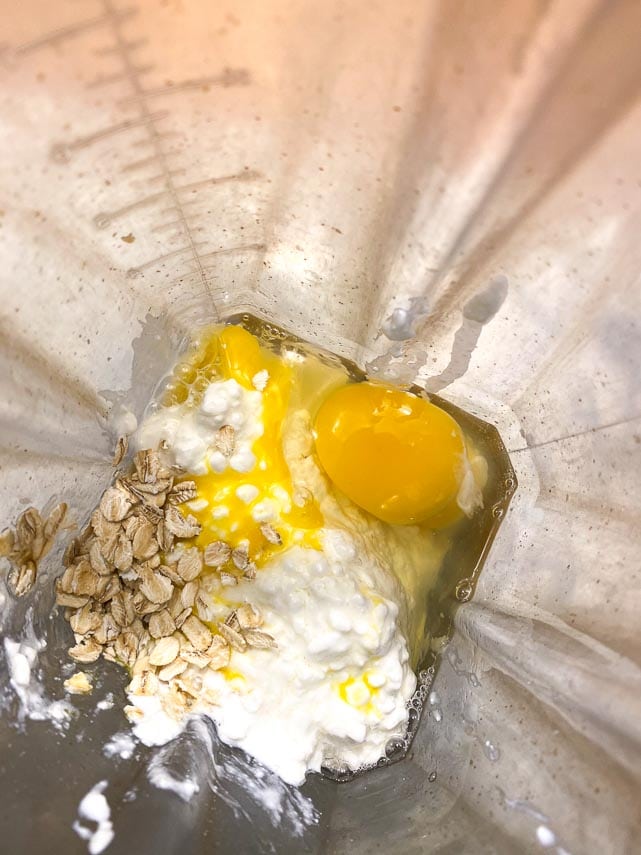
Blend away! Scrape down if needed. Let sit for 2 to 5 minutes while you get out your pan and begin heating it.
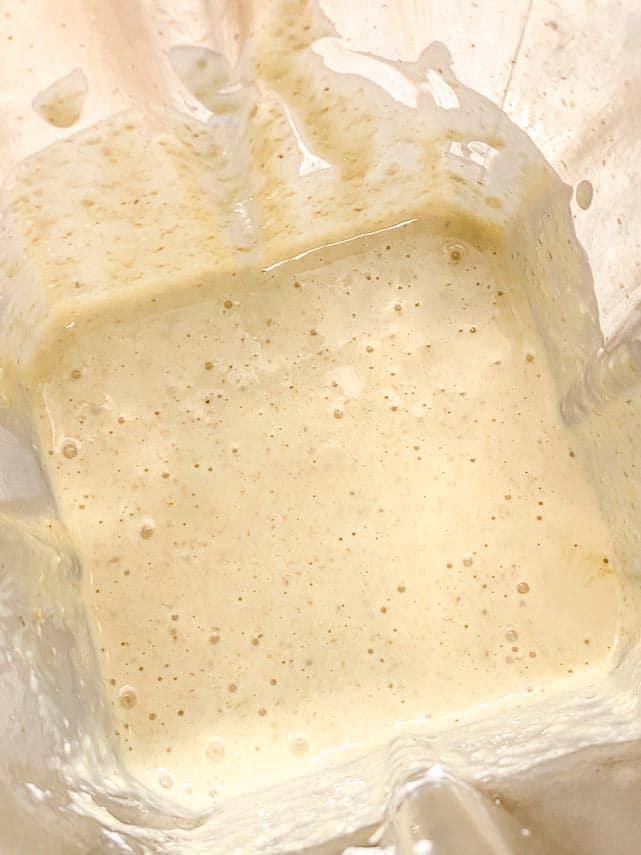
You can use any kind of skillet – even an electric skillet. Heat over low-medium heat and coat with nonstick spray. Dole out a few at a time; don’t crowd the pancakes in the pan.
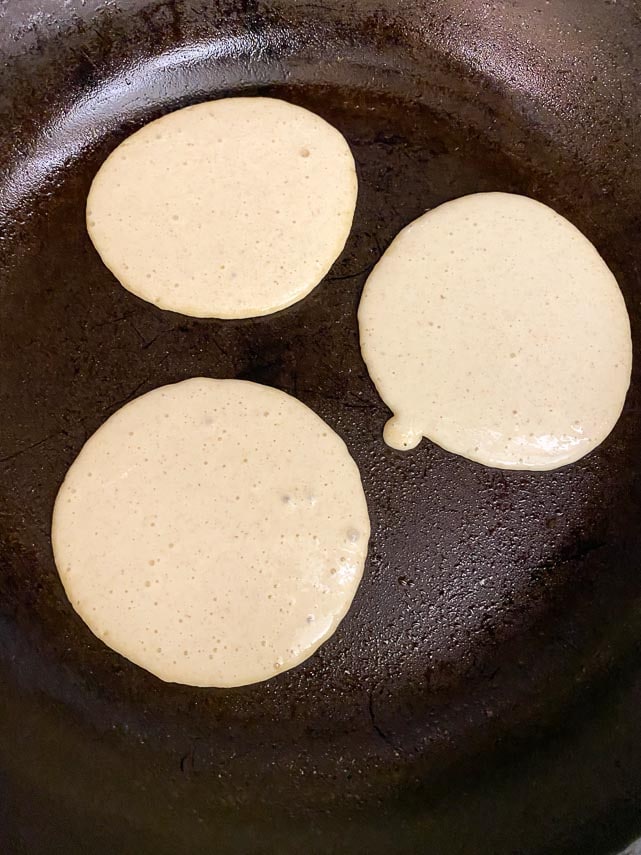
Cook until some bubbles rise to the surface a pop. If you peek, the bottoms should be golden before flipping.
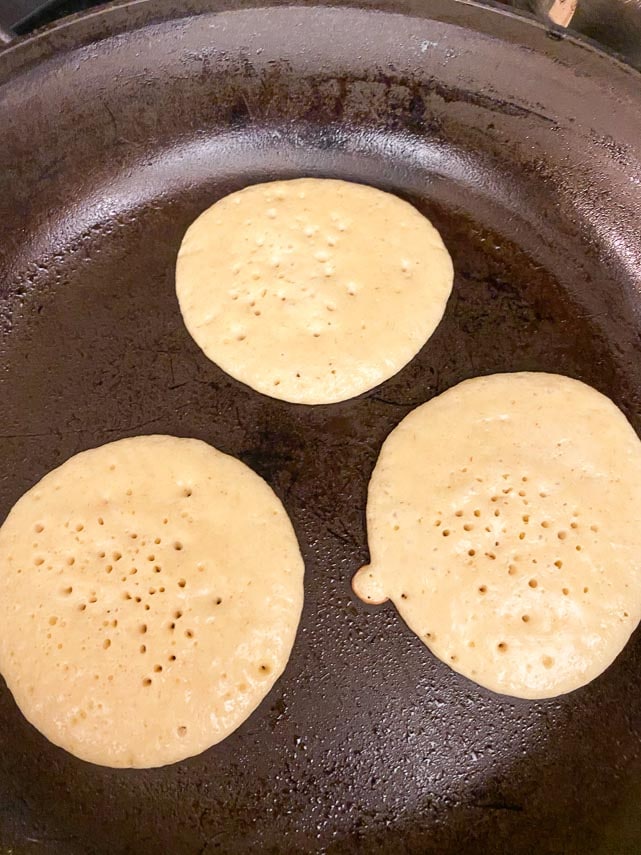
PS: It is really nice to heat up your maple syrup, too.
Now you are ready to serve!
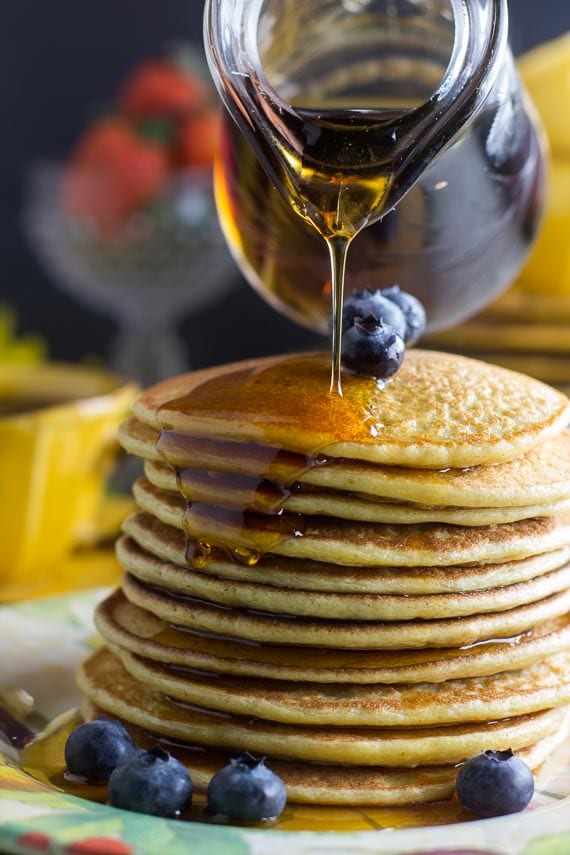
Low FODMAP Pancakes & Waffles
Looking for more breakfast treats? Check out these recipes:
- 3-Seed Dairy-Free Pancakes
- Buttermilk Oat Pancakes
- Sheet-Pan Pancakes
- Buckwheat Banana Pancakes
- Quinoa Pancakes
- Browned Butter Coconut Pancakes
- Chocolate Pancakes
- Gingerbread Pancakes
- Potato Pancakes (Latkes!)
- Cheddar Waffles With Bacon & Chives
- Cornbread Waffles
- Red Velvet Waffles
- Lemon Poppy Seed Waffles
- Banana Oat Waffles
- Dark Chocolate Waffles
Ands we have an entire article devoted to ALL THINGS BREAKFAST that takes you beyond pancakes and waffles.
FODMAP Information
All recipes are based upon Monash University & FODMAP Friendly science at time of initial publication.
- Eggs: Eggs are high in protein and do not contain carbohydrates, according to Monash University.
- Lactose-Free Dairy: Lactose-free dairy, such as lactose-free milk or lactose-free cream cheese, has lactase enzyme added that breaks the disaccharide molecules and creates a more digestible dairy product, from a lactose perspective. The resulting product is not dairy-free, but it is lactose-free. Some products might have miniscule amounts of lactose remaining, but the amount is small enough for the product to be labeled as lactose-free. For instance, Breyers Lactose-Free Vanilla Ice Cream states it is 99% lactose-free, while Lactaid Vanilla Ice Cream states it is 100% lactose-free.
- Maple Syrup: Both Monash University and FODMAP Friendly have lab tested maple syrup. Monash says that maple syrup is Green light and low FODMAP in servings of 2 Australian tablespoons (50 g). FODMAP Friendly gives it a “Pass” at 2 tablespoons (53 g). These amounts are likely recommended due to Australian healthy eating guidelines; no upper limit is posted by either Monash or FODMAP Friendly.
- Oats: Both Monash and FODMAP Friendly have both lab tested oats. FODMAP Friendly gave rolled oats a “Pass” at ½ cup or 43 g servings; in an update to the app they report Quick Oats (which are just rolled oats chopped up a bit) as low FODMAP at 47 g, or ½ cup uncooked. Their max low FODMAP serving is 59.53 g. Monash has several app entries and some are country specific. Here we present their “basic” app entries which are not country specific (use your app to look up the other entries). For their main entry called “rolled oats” they say a Green Light low FODMAP serving is ½ cup, which they peg at 52 g. For “quick oats” they state that a low FODMAP serving is only ¼ cup at 23 g, becoming moderate Yellow Light at ½ cup or 47 g.
Please always refer to the Monash University & FODMAP Friendly smartphone apps for the most up-to-date lab tested information. Foods will be retested from time to time; in the case of raw ingredients, such as fruits and vegetables, results may vary. All lab tested results are valid and represent a snapshot in time. As always, your tolerance is what counts; please eat accordingly. The ultimate goal of the low FODMAP diet is to eat as broadly as possible, without triggering symptoms, for the healthiest microbiome.
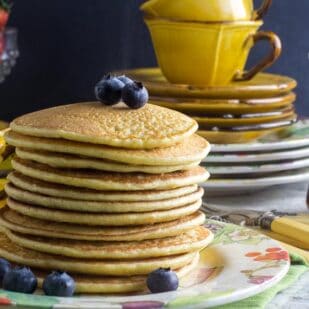
Low FODMAP 3-Ingredient High Protein Pancakes
Low FODMAP 3-Ingredient High Protein Pancakes: rolled oats, lactose-free cottage cheese and eggs. That’s all it takes. If you have some salt and vanilla extract around, you can add them, but you really can make these pancakes with just the three main ingredients. (See Tips for add-ins).
Low FODMAP Serving Size Info: Makes about 12, 3-inch (7.5 cm) pancakes; 4 servings; 3 pancakes per serving
Ingredients:
- 2 large eggs
- ½ cup (113 g) lactose-free cottage cheese, such as Green Valley Creamery
- ½ cup (50 g) old-fashioned rolled oats; use gluten-free if following a gluten-free diet
Preparation:
-
Get out your blender! Break eggs into blender, then scrape in the cottage cheese. Add oats. Blend until super smooth, scraping down carafe if needed. Let sit for a few minutes while you prepare your pan, prep your fruit (if using) and warm your maple syrup.
-
Heat electric griddle, heavy skillet or nonstick pan. Coat with nonstick spray and heat until a few drops of water dance. Dole out 3 tablespoon amounts of batter at a time (we use an ice cream scoop) and cook over medium heat until bubbles begin to appear here and there, about 1 minute or so. The bottoms should be golden brown. Flip over and cook for about 1 minute more or until that side is golden brown as well. Serve hot with real maple syrup – and fruit, if you like. Low FODMAP portions, of course. These pancakes are really best freshly enjoyed; serve immediately.
Notes:
Tips
• There are some simple add-ins that you can toss in your blender if you like. Consider a large pinch of salt, cinnamon or even a bit of vanilla extract – or all of them!
• These pancakes, as you can see, are not thick and fluffy – they are rather thin. If you would like to “fluff them up”, try adding ½ teaspoon baking powder to the blender. (Use gluten-free if following a gluten-free diet).
FODMAP Information
All recipes are based upon Monash University & FODMAP Friendly science at time of initial publication.
- Eggs: Eggs are high in protein and do not contain carbohydrates, according to Monash University.
- Lactose-Free Dairy: Lactose-free dairy, such as lactose-free milk or lactose-free cream cheese, has lactase enzyme added that breaks the disaccharide molecules and creates a more digestible dairy product, from a lactose perspective. The resulting product is not dairy-free, but it is lactose-free. Some products might have miniscule amounts of lactose remaining, but the amount is small enough for the product to be labeled as lactose-free. For instance, Breyers Lactose-Free Vanilla Ice Cream states it is 99% lactose-free, while Lactaid Vanilla Ice Cream states it is 100% lactose-free.
- Maple Syrup: Both Monash University and FODMAP Friendly have lab tested maple syrup. Monash says that maple syrup is Green light and low FODMAP in servings of 2 Australian tablespoons (50 g). FODMAP Friendly gives it a “Pass” at 2 tablespoons (53 g). These amounts are likely recommended due to Australian healthy eating guidelines; no upper limit is posted by either Monash or FODMAP Friendly.
- Oats: Both Monash and FODMAP Friendly have both lab tested oats. FODMAP Friendly gave rolled oats a “Pass” at ½ cup or 43 g servings; in an update to the app they report Quick Oats (which are just rolled oats chopped up a bit) as low FODMAP at 47 g, or ½ cup uncooked. Their max low FODMAP serving is 59.53 g. Monash has several app entries and some are country specific. Here we present their “basic” app entries which are not country specific (use your app to look up the other entries). For their main entry called “rolled oats” they say a Green Light low FODMAP serving is ½ cup, which they peg at 52 g. For “quick oats” they state that a low FODMAP serving is only ¼ cup at 23 g, becoming moderate Yellow Light at ½ cup or 47 g.
Please always refer to the Monash University & FODMAP Friendly smartphone apps for the most up-to-date lab tested information. Foods will be retested from time to time; in the case of raw ingredients, such as fruits and vegetables, results may vary. All lab tested results are valid and represent a snapshot in time. As always, your tolerance is what counts; please eat accordingly. The ultimate goal of the low FODMAP diet is to eat as broadly as possible, without triggering symptoms, for the healthiest microbiome.
Nutrition
All nutritional information is based on third-party calculations and should be considered estimates. Actual nutritional content will vary with brands used, measuring methods, portion sizes and more. For a more detailed explanation, please read our article Understanding The Nutrition Panel Within Our Recipes.
